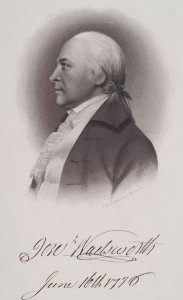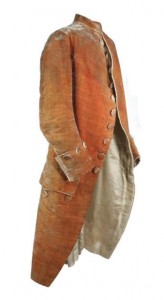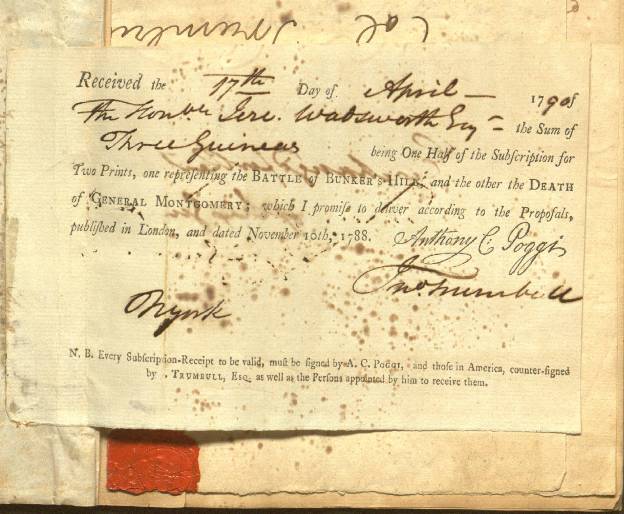By Joel Lang
Jeremiah Wadsworth was a sea-going merchant, commissary general to the Continental army, and founder of the nation’s first banks. He also helped established the insurance and textile industries in Connecticut and served in the first three terms of the US Congress.
Had he lived in another era, his wealth and influence might have made him a figure comparable to a 19th-century financial tycoon or a 20th-century venture capitalist. As it was, the fortune he amassed, valued at $125,000 according to probate records, was one of the largest of his time and seeded the 1842 creation of the Wadsworth Atheneum (as it was then called), the nation’s oldest public art museum and one of Hartford’s most enduring institutions.
Younger Years and West Indies Trade

Jeremiah Wadsworth, 1776, engraving – By John Angel James Wilcox, Connecticut Museum of Culture and History. Used through Public Domain.
Jeremiah was born on July 12, 1743, to Daniel Wadsworth, minister at Hartford’s First Church, and Abigail Talcott, the daughter of Joseph Talcott, Colony governor from 1725 to 1741. Losing both parents as a child, he was raised by his uncle, Matthew Talcott, a ship owner in Middletown, then an important Connecticut river port.
His uncle sent him to sea in 1761, introducing Jeremiah to the West Indies trade. Within a decade he had become a ship’s captain and a wealthy man. As ship commander, he was as much merchant as mariner, since his duties required him to decide where and when to sell his cargo, not just transport it.
His mercantile skills led to his appointment in 1774 as commissary (supply master) for the Connecticut militia. At the outbreak of the Revolutionary War, he advanced to commissary for the eastern division of the Continental army and in 1778 succeeded Joseph Trumbull as commissary general for the entire army.
He earned the trust of General George Washington and his reputation withstood claims he profited excessively from his post, which paid by commission. He resigned in 1780, only to soon act as commissary to the 5,500-soldier French army led by Jean-Baptiste-Donatien de Vimeur, comte de Rochambeau.
Later Life and Further Wealth
At the peak of his mercantile ventures, Wadsworth had trading partners in England, France, and Ireland as well as in larger colonial cities and the West Indies. One of his notable local partnerships was formed in 1779 with Barnabas Deane, brother of Silas, and General Nathaniel Greene of Rhode Island. The partnership built a large distillery and owned a fleet of ships to supply the distillery with molasses from the West Indies.

Coat originally owned by Colonel Jeremiah Wadsworth, 1784 – Connecticut Museum of Culture and History. Used through Public Domain.
Wadsworth began to invest some of his wealth in banks even before the Revolution ended. His ownership of 104 of its 1,000 shares made him the largest shareholder in the continent’s first bank, the Bank of North America, founded in Philadelphia in 1781. He served as president of the Bank of New York, founded in 1784, and as a director of the first Bank of the United States, chartered by Congress in 1791 and located in Philadelphia.
In 1792, he was a driving force behind the founding of the Hartford Bank, the city’s first, which later became Hartford National. An anniversary history published in 1892 described Wadsworth as “the wealthiest man in town … foremost in every enterprise which promised to advance its prosperity.”
Among those other enterprises were Connecticut’s first insurance partnership, in 1794, and the Hartford Woolen Manufacture, the first mill to use power machinery to spin broadcloth. The owner of three farms, he also was noted for importing new breeds of cattle and for his experiments with crops. The inventory of Wadsworth’s estate showed the largest share of his wealth was in bank stock and farm property. He also had a large library of 1,000 volumes.
Wadsworth had married Mehitable Russell in 1767. They had three children, including Daniel. Besides founding the Atheneum, Daniel would use the fortune he inherited to fund the construction of the present-day Center Church, replacing First Church, and to restore the adjacent Ancient Burial Ground, where his father was one of the last to be interred after his death in 1804.
Joel Lang retired in 2007 from the Hartford Courant, where he wrote mostly for Northeast, its Sunday magazine; he currently resides in Bridgeport.









